As I was surrounded by a sea of varying colors of green, I had to remind myself to keep on the well-trodden path as there could have been some remaining undiscovered active landmines… although less likely in the year 2017, as they have been largely deactivated and unearthed, it is better to be safe than sorry. My husband and I were at the 17th parallel, the former Vietnam DMZ (Demilitarized Zone), a demarcated area that separated South and North Vietnam during what Americans call the Vietnam War and what the Vietnam government calls the American War – this is where the majority of lives were lost during a war that lasted from 1955 until 1975. It was just as stunning in its raw beauty as so many Vietnam Veterans, or vets (Americans who fought in the war) had described it to me. One vet not only told me about the surreal natural splendor of the Vietnam landscape, but he also talked about the kindness of the South Vietnamese people who took care of his army unit. He still had a picture next to his bed of a Vietnamese woman who would make fish soup for them… she was a temporary mother to his 18 year old self, and to this day, her picture is a reminder of the better memories from that experience.
There is No Sugar Coating It
 Vietnam is an intensely authentic place… I know people are tired of the word “authentic” but I think, in this case, it is rightfully used. Although, if you go through a very touristy place like Hoi An, a delightfully restored ancient area the Old Town section anyways (recently named a UNESCO World Heritage site), you will be bombarded with the local Vietnamese trying to sell you stuff… so yes, like any other tourist place on the planet, be wary… but when you go off the beaten path, people are living their lives openly in the streets… hanging clothes up, burning things that they want to send to their deceased relatives, screaming at each other (or perhaps just loudly having a pleasant conversation?)… many people’s doors were open where I could see them taking a mid-day nap when the temperatures hit 120F (49C), and I would think, sweat pouring down my face, “I am such a sucker running around during this time of day!”… and hints of rusty sections of the dilapidated buildings would gleam in the fierce sun. No one was trying to compete with each other, show that they were better than anyone else, or trying to pretend they were something they were not… they were living their lives, content with very little… of course this is not true for everyone, as we had some interesting conversations with some local people about a movement to make South Vietnam a more capitalist area of Vietnam… but I think in every country there is at least one group, if not more, that feels alienated by their government.
Vietnam is an intensely authentic place… I know people are tired of the word “authentic” but I think, in this case, it is rightfully used. Although, if you go through a very touristy place like Hoi An, a delightfully restored ancient area the Old Town section anyways (recently named a UNESCO World Heritage site), you will be bombarded with the local Vietnamese trying to sell you stuff… so yes, like any other tourist place on the planet, be wary… but when you go off the beaten path, people are living their lives openly in the streets… hanging clothes up, burning things that they want to send to their deceased relatives, screaming at each other (or perhaps just loudly having a pleasant conversation?)… many people’s doors were open where I could see them taking a mid-day nap when the temperatures hit 120F (49C), and I would think, sweat pouring down my face, “I am such a sucker running around during this time of day!”… and hints of rusty sections of the dilapidated buildings would gleam in the fierce sun. No one was trying to compete with each other, show that they were better than anyone else, or trying to pretend they were something they were not… they were living their lives, content with very little… of course this is not true for everyone, as we had some interesting conversations with some local people about a movement to make South Vietnam a more capitalist area of Vietnam… but I think in every country there is at least one group, if not more, that feels alienated by their government.
 I like the transparency of how people live in Vietnam… or as some may say, the grit. Albeit a communist country, it has a loosey-goosey, anything goes feeling, where, for example, a red traffic light doesn’t necessarily mean that everyone on a motorbike will stop. And talking about motorbikes, there are tons of them… with all these easy riders driving on tiny bikes with 3, 4, sometimes 5 people. People transport huge deliveries, windows and livestock on these tiny bikes. Most people can’t afford anything else and people do what they have to do to survive. Even though, as a tourist, I would be cautious as I would be in any other city in a foreign country – never knowingly break the law… no matter how insignificant you think the law is.
I like the transparency of how people live in Vietnam… or as some may say, the grit. Albeit a communist country, it has a loosey-goosey, anything goes feeling, where, for example, a red traffic light doesn’t necessarily mean that everyone on a motorbike will stop. And talking about motorbikes, there are tons of them… with all these easy riders driving on tiny bikes with 3, 4, sometimes 5 people. People transport huge deliveries, windows and livestock on these tiny bikes. Most people can’t afford anything else and people do what they have to do to survive. Even though, as a tourist, I would be cautious as I would be in any other city in a foreign country – never knowingly break the law… no matter how insignificant you think the law is.
The Free Spirits of Australians and Vietnamese
Any time we heard a non-Vietnamese voice during our trip, 7 out of 10 times it had an Australian accent. Like the locals, many Australians seemed to completely give themselves over to the Vietnamese way of life of riding motorbikes in chaotic traffic, and I think they somehow innately knew what the unspoken rules were in any given situation. Being a somewhat neurotic New Yorker, I could never ride a motorbike… even if I was just on it as a passenger with a professional driver. We all have our limits – I have no issues just walking through a local neighborhood and jumping into a random eatery; I brought my own toilet paper and I have had my typhoid and hepatitis immunizations updated so I was good to go… but if anyone knows real New Yorkers, we love to eat in hole in the wall restaurants… or at food trucks…. so not that much of a stretch for me.
But I did sit back and enjoy seeing how the Australians intermixed effortlessly with the Vietnamese. There was something playful about how people lived their life in Vietnam and the Australians fit in perfectly. Americans have always admired the seemingly free spirit of those who come from the “land down under.” Almost every other place on Earth is a big trip for Australians, and I think that’s why you see many traveling the world as they are used to it, and hence don’t fear travel. Ho Chi Minh City, Vietnam, is around an 8 hour flight from Sydney, Australia, and so relatively, it is not that big of a trip for our Aussie friends.
Ungrafted: Old Vines and Why They Matter
 Three weeks before I left for Vietnam, I went to an Australian wine seminar that was based on the old, ungrafted vines that are unbeknownst to many Americans. The US consumer has had a very positive, albeit somewhat dysfunctional, relationship with Australian wines. The entry level to mid-market wines, at $7 to $12, really took off in the mid-1990s (although the biggest current category for them in the US is the $15-20) and the general attitude that Australians were a down-to-earth people who lacked pretense or judgment towards the American palate just made the wines that much more psychologically approachable. You always want to support those who you think support you. But as the Australian dollar surged high against the US dollar, and also considering other countries with cheaper labor were able to undercut their prices, it became impossible for Australia to keep their wines a steal, and hence, they lost center stage placements in many wine retailers in the US.
Three weeks before I left for Vietnam, I went to an Australian wine seminar that was based on the old, ungrafted vines that are unbeknownst to many Americans. The US consumer has had a very positive, albeit somewhat dysfunctional, relationship with Australian wines. The entry level to mid-market wines, at $7 to $12, really took off in the mid-1990s (although the biggest current category for them in the US is the $15-20) and the general attitude that Australians were a down-to-earth people who lacked pretense or judgment towards the American palate just made the wines that much more psychologically approachable. You always want to support those who you think support you. But as the Australian dollar surged high against the US dollar, and also considering other countries with cheaper labor were able to undercut their prices, it became impossible for Australia to keep their wines a steal, and hence, they lost center stage placements in many wine retailers in the US.
 As time went on, the US became more wine savvy in some ways while reinforced unfair stereotypes in other ways. We started to assume that Australia could not make complex, elegant wines because our ignorance was based on the wines that first flooded our market which were jammy, sweet fruit libations with a touch of residual sugar, ideal for the US wine neophytes at the time. But as artisanal wine consumption and consumers’ desire for wanting to inform themselves has quickly increased in the US, somehow the tiny production of extremely old vines tucked away in different pockets of Australia did not appear on the radar of many fine wine sommeliers and connoisseurs in America.
As time went on, the US became more wine savvy in some ways while reinforced unfair stereotypes in other ways. We started to assume that Australia could not make complex, elegant wines because our ignorance was based on the wines that first flooded our market which were jammy, sweet fruit libations with a touch of residual sugar, ideal for the US wine neophytes at the time. But as artisanal wine consumption and consumers’ desire for wanting to inform themselves has quickly increased in the US, somehow the tiny production of extremely old vines tucked away in different pockets of Australia did not appear on the radar of many fine wine sommeliers and connoisseurs in America.
Australia has an astonishingly impressive, still existing, old vine history with the first vines planted in 1788 – only 10 years after the British settlement in Australia. It became a country for adventurous UK citizens who were willing to take the risk as well as others who were desperate for another opportunity in life, as well as a place where the British government shipped convicts, around 164,000 of them between 1788 and 1868. In 1901, Australia gained their independence and they became the Commonwealth of Australia, with their own governing rules. This event started an explosion of creativity and innovation while also allowing Australians to find their own distinct culture. Three of the wines we had during the seminar had a combined vine age of 452 years… that was only three of the wines.
A Part of Ourselves
In my experience, Australian producers are completely transparent and have a self-effacing humor. They do not want to spin a mystical tale or present themselves as being better than anyone else; instead, they enthusiastically tell you the good, bad and the ugly of their situations, laugh about their colorful past, and proudly display their wines for the unique creations that they are. They want to tell you exactly what you are getting, show it to you, allow you to dissect it, and empower you to make your own mind about the diversity of their fine wines. I almost get the feeling that they despise any sort of fake veneer. Some marketers argue that Australians don’t sprinkle enough PR fairy dust on their regional images or even for individual producers, but they give it to you straight… they work hard and they feel they have nothing to be ashamed of… so why not share the full reality of their stories?
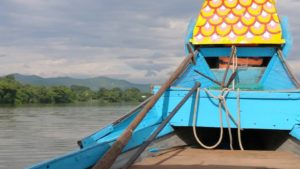 This was my third trip to Vietnam, and to be honest, I’m not 100% sure why we keep going back. Perhaps it is part of resolving certain things that happened in the Vietnam War that still haunt many Americans today… so much so that people don’t like to talk about it. There have been some American vets who have moved to different parts of Vietnam, embracing the past to heal for a better future. There are a few who have set up tours for other vets to come and meet former North Vietnam soldiers so they can hug, talk and help each other find closure, because, at the end of the day, most of the soldiers who were on the frontlines were just kids who thought they were serving the greater good… as time goes on we realize it is a lot more complicated than the simple assessment of who was right and who was wrong.
This was my third trip to Vietnam, and to be honest, I’m not 100% sure why we keep going back. Perhaps it is part of resolving certain things that happened in the Vietnam War that still haunt many Americans today… so much so that people don’t like to talk about it. There have been some American vets who have moved to different parts of Vietnam, embracing the past to heal for a better future. There are a few who have set up tours for other vets to come and meet former North Vietnam soldiers so they can hug, talk and help each other find closure, because, at the end of the day, most of the soldiers who were on the frontlines were just kids who thought they were serving the greater good… as time goes on we realize it is a lot more complicated than the simple assessment of who was right and who was wrong.
That’s why I try to remind myself that there is so much I don’t know and may never figure out… at certain times, I try to just shut my mouth, leave the assumptions at home, and open myself up to what someone has to say. My previous New York City trade experience was with fine wine and it was nice to get a more inclusive look into the fine wine world that I have been acquainted with for many years. The frank world of the old vines in Australia is a refreshing and invigorating one. Like the 25 hour door-to-door trip from New York City to Central Vietnam, it takes a little bit more effort to seek out these old vine Australian wines, but it was worth it to expand our own bubble. Instead of allowing a one sentence soundbite to form our opinions, we can choose to seek out as much of the whole story as we can digest, as well as appreciate those we encounter who veraciously share their own tale that may not always correspond with our initial impressions.
If we constantly live in denial of the less-than-desirable aspects of our story, we eventually become numb to the beautiful facets of life… like that one vet refusing to pretend that Vietnam didn’t happen so others would not feel uncomfortable… he wanted to hold on to the memory of his temporary Vietnamese mother. Maybe the Australian fine wine producers are not so foolish… they may have a pretty good handle on knowing that being honest about their entire journey is the only way to guarantee security for the future generations… and even if it is not, it is a pretty fine way to live one’s life.
*************************************************
Tasting at Australian Ungrafted Old Vines Seminar on June 7th, 2017
The below is a chart that shows the Barossa Old Vine Charter classifying the meaning of various old vine terms, actually old vines typically have no specific age range in many other countries and it is more of a judgment call from the producer, and although this is specific to the region of Barossa Valley, it is a good reference for other regions in Australia.
The University of Adelaide has been researching ungrafted old vines (ungrafted: many old vines in Europe and North America need to be grafted due to the pest phylloxera) The report has not been released yet but is anticipated soon.
Email research@wineaustralia.com if you would like to be notified once the research is released.
Also, some of the bottles below had a screw cap and some had cork (one glass closure)… here is some research from The Australian Wine Research Institute that addresses the idea of aging under different closures.
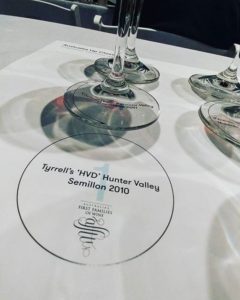 –2010 Tyrrell’s Single Vineyard ‘HVD’, Semillon, Hunter Valley, Australia (screw cap): Hunter Valley Semillon is one of those wines that is truly unique to Australia. Hunter Valley is 80 miles (130 km) north of Sydney and it is a zone that only contributes about 3% to the total Australian wine production. Another odd thing about this highly heralded fine wine region is that the climate is hot, humid and rainy… so picking early is essential. Typically, the alcohol range is between 8 to 9% abv, yet this particular Hunter Valley Semillon is 11% abv. Bruce Tyrrell, managing director, said he wanted to start picking his Semillon a little later than what is normal in the Hunter Valley… that way the wine is more generous at a younger age. One cannot truly appreciate these wines unless you have had one at the minimum age of 20 years old, and they can last a couple more decades past that depending on the quality of the wine. As Bruce said, these wines “used to have a reputation for being like battery acid” with low alcohol, high acidity and a light body when they were consumed too young. But his 7 year example was certainly friendlier than its counterparts at the same age, with notes of lime zest, honeysuckle and a flinty smoke… still lots of tension, with an electric acidity that was tempered by a little bit more fruit and alcohol than normal. This wine will continue to improve for 20 years if not longer.
–2010 Tyrrell’s Single Vineyard ‘HVD’, Semillon, Hunter Valley, Australia (screw cap): Hunter Valley Semillon is one of those wines that is truly unique to Australia. Hunter Valley is 80 miles (130 km) north of Sydney and it is a zone that only contributes about 3% to the total Australian wine production. Another odd thing about this highly heralded fine wine region is that the climate is hot, humid and rainy… so picking early is essential. Typically, the alcohol range is between 8 to 9% abv, yet this particular Hunter Valley Semillon is 11% abv. Bruce Tyrrell, managing director, said he wanted to start picking his Semillon a little later than what is normal in the Hunter Valley… that way the wine is more generous at a younger age. One cannot truly appreciate these wines unless you have had one at the minimum age of 20 years old, and they can last a couple more decades past that depending on the quality of the wine. As Bruce said, these wines “used to have a reputation for being like battery acid” with low alcohol, high acidity and a light body when they were consumed too young. But his 7 year example was certainly friendlier than its counterparts at the same age, with notes of lime zest, honeysuckle and a flinty smoke… still lots of tension, with an electric acidity that was tempered by a little bit more fruit and alcohol than normal. This wine will continue to improve for 20 years if not longer.
There is not much money in these types of wines as one makes such a tiny quantity, and they have to hold back on release, but as Bruce Tyrrell said, “This stuff runs in my blood” and so he is committed to these wines. No other country has even attempted anything close to Hunter Valley Semillon, and perhaps one needs to be a little crazy, in the good way, to do so. Personally, the first time I had one it was already 30-ish years old, then I tried a 40-ish year old, and these wines become liquid gold. But it is nice that consumers can get a sense of these wines at a younger age with a producer like Tyrrell.
This HVD plot was planted in 1908. Production is hand picked and hand sorted in the vineyard, through the crusher and press as quickly as possible, stainless steel cool fermented with neutral yeasts, stabilized, and put away in temperature controlled storage.
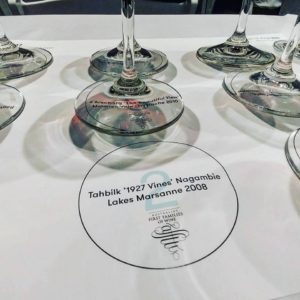 –2008 Tahbilk, ‘1927 Vines’, Marsanne, Nagambie Lakes, Australia (screw cap): Nagambie Lakes is a sub-region of the Goulburn Valley wine region – the oldest wine region in Victoria. Although most wine states in Australia are phylloxera free (the pest that makes it necessary to graft vines in many countries), Victoria is a state that does have phylloxera, and so, one may ask, how they have ungrafted vines in this particular vineyard started in 1927? Sandy soils. Luckily, phylloxera cannot climb up in sandy soils, and so usually they cannot damage the vines. Marsanne is one of those varieties from the Rhône Valley, in France, that either people love or hate. There are certainly some mediocre Marsanne wines out there, or blends, but there are some exceptional ones and Tahbilk is legendary among those who love Marsanne to be the quintessential outstanding example of this white grape. This wine is based on the Hunter Valley Semillon old school technique of winemaking – with slightly higher alcohol at 11.5% – and it is ferociously acidic and may even outlive my 42 year old self. But it seems to have just started to come into its own with aromas of crumbly rock intermixed with flavors of golden apples drizzled with honey. It is texturally quite complex in the mouth as well.
–2008 Tahbilk, ‘1927 Vines’, Marsanne, Nagambie Lakes, Australia (screw cap): Nagambie Lakes is a sub-region of the Goulburn Valley wine region – the oldest wine region in Victoria. Although most wine states in Australia are phylloxera free (the pest that makes it necessary to graft vines in many countries), Victoria is a state that does have phylloxera, and so, one may ask, how they have ungrafted vines in this particular vineyard started in 1927? Sandy soils. Luckily, phylloxera cannot climb up in sandy soils, and so usually they cannot damage the vines. Marsanne is one of those varieties from the Rhône Valley, in France, that either people love or hate. There are certainly some mediocre Marsanne wines out there, or blends, but there are some exceptional ones and Tahbilk is legendary among those who love Marsanne to be the quintessential outstanding example of this white grape. This wine is based on the Hunter Valley Semillon old school technique of winemaking – with slightly higher alcohol at 11.5% – and it is ferociously acidic and may even outlive my 42 year old self. But it seems to have just started to come into its own with aromas of crumbly rock intermixed with flavors of golden apples drizzled with honey. It is texturally quite complex in the mouth as well.
Tahbilk’s association with Marsanne can be traced back to the 1860s – and this vineyard was planted in 1927 – they are the oldest winery in Victoria in a sub-region called Nagambie Lakes in Central Victoria – only 90 minutes north of Melbourne. Nagambie Lakes is the only Australian wine region, and one of only six worldwide, where it has been proven that the meso-climate is dramatically influenced by the inland water mass.
Alister Purbrick, CEO of Tahbilk, 4th generation winemaker (his daughter may be 5th and his grandsons may be 6th) talked about the winemaking for this wine…. harvest early, don’t add a lot of chemicals, drain as best they can and are then left with a brown juice with a high acid backbone… then they ferment it and all the brown oxidized matter falls to the bottom, and at the end of the ferment they are left with a “water white, flavorless, incredibly acidic white wine which you could not sell on the open market in its 1st year, 2nd year, 3rd year or 4th year”. Alister says all the “magic happens with bottle age”. The 2008 is their current release of this wine.
 –2016 Best’s Great Western ‘Old Vine’, Pinot Meunier, Grampians, Western Victoria Zone, Australia (screw cap): The Great Western is a sub-zone within the cooler Grampians area of Western Victoria. It is certainly a rare treat to taste a 100% Pinot Meunier outside of Champagne, and even in Champagne, 100% Pinot Meunier is atypical…besides noting that a 100% Pinot Meunier as a still wine is even more impossible to find. This vineyard was planted in 1865 and this 100% bottling is only made when it yields extraordinary fruit so this is only the 4th bottling for Best’s – 2005, 2008, 2012 and 2016 were the vintages made. This wine has a lovely nimble body that gracefully dances on the palate, yet no hint of greenness… floral and pristine raspberry notes dominate with some stony undertones. This is the sort of wine I would love to drink everyday… perhaps when I make it to Nirvana!
–2016 Best’s Great Western ‘Old Vine’, Pinot Meunier, Grampians, Western Victoria Zone, Australia (screw cap): The Great Western is a sub-zone within the cooler Grampians area of Western Victoria. It is certainly a rare treat to taste a 100% Pinot Meunier outside of Champagne, and even in Champagne, 100% Pinot Meunier is atypical…besides noting that a 100% Pinot Meunier as a still wine is even more impossible to find. This vineyard was planted in 1865 and this 100% bottling is only made when it yields extraordinary fruit so this is only the 4th bottling for Best’s – 2005, 2008, 2012 and 2016 were the vintages made. This wine has a lovely nimble body that gracefully dances on the palate, yet no hint of greenness… floral and pristine raspberry notes dominate with some stony undertones. This is the sort of wine I would love to drink everyday… perhaps when I make it to Nirvana!
 –2011 Cirillo ‘1850’, Grenache, Barossa Valley, Australia (screw cap): If you know anything about Australia fine wines then I’m sure you know of Barossa Valley. Stephen Henschke, winemaker at Henschke, was kind enough to talk a little bit about Barossa. English, Scottish and German immigrants settled Barossa Valley before the first pre-settlement, so he joked that the rest of the panel, including himself, who were established outside of Barossa were “just convicts”…hehehe…
–2011 Cirillo ‘1850’, Grenache, Barossa Valley, Australia (screw cap): If you know anything about Australia fine wines then I’m sure you know of Barossa Valley. Stephen Henschke, winemaker at Henschke, was kind enough to talk a little bit about Barossa. English, Scottish and German immigrants settled Barossa Valley before the first pre-settlement, so he joked that the rest of the panel, including himself, who were established outside of Barossa were “just convicts”…hehehe…
Although 14% abv, there was no sense of the alcohol on this Cirillo beauty… a good backbone of structure that one does not expect from Grenache, with some grip on the fine tannins, yet lots of flesh to balance it out. Sweet red cherries dominate with complex layers of tar and earth.
Stephen talked about the clonal diversity of Grenache and that each clone has its own attributes… some are light with big berries, others have looser bunches with small berries and darker color – this vineyard has a combination of these clones. He also remarked on the 2011 vintage, “2011 is one of the worst on record” like the tough 1974 vintage — rainy, cooler weather unlike the warmer, drier climate they typically expect in the Barossa Valley and it is a testament to these old vines, from 1850, that they were able to produce such an exquisite wine.
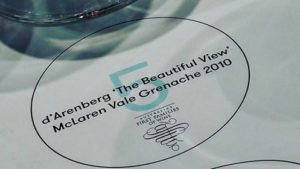 –2010 d’Arenberg ‘The Beautiful View’ Grenache, McLaren Vale, Australia (screw cap): McLaren Vale is another infamous wine region, with d’Arenberg being one of their international stars due mainly to rock star, family owner and chief winemaker, Chester Osborne. I have tasted many d’Arenberg wines over the years, and even though McLaren Vale wines can easily go over 15% abv, the d’Arenberg wines never come off as being hot and they always have an overall finesse and complexity that is distinctly their own. By the way, this wine is only 14% abv… and most importantly, it is balanced… silky texture with a more lavish body than the Cirillo… still it has a thrilling acidity on the finish with wild berries and spice.
–2010 d’Arenberg ‘The Beautiful View’ Grenache, McLaren Vale, Australia (screw cap): McLaren Vale is another infamous wine region, with d’Arenberg being one of their international stars due mainly to rock star, family owner and chief winemaker, Chester Osborne. I have tasted many d’Arenberg wines over the years, and even though McLaren Vale wines can easily go over 15% abv, the d’Arenberg wines never come off as being hot and they always have an overall finesse and complexity that is distinctly their own. By the way, this wine is only 14% abv… and most importantly, it is balanced… silky texture with a more lavish body than the Cirillo… still it has a thrilling acidity on the finish with wild berries and spice.
‘The Beautiful View’ Grenache was planted in 1912. Their winemaker, Toby Porter, was in attendance and he said that there has not been one dull moment in his 14 years at d’Arenberg – they make 24 different wines, export to 70 countries and they have a total of 450 hectares of vines that are organic and biodynamic that always strive for low yields…. no wonder he is not bored!
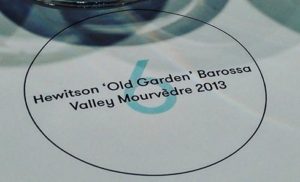 –2013 Hewitson ‘Old Garden’, Mourvèdre, Barossa Valley, Australia (cork): Some may know Australian Mourvèdre by the name of Mataro… Mourvèdre is the French name for this grape and in Spain it is known as Monastrell. I think the importance of these different names draws attention to the fact that although they are the same grape variety, they have morphed into a diversified set of clones (or biotypes, whatever term works for you) due to evolving to suit their different environments. So Australian Mourvèdre is a different animal. The first notes on this Hewitson ‘Old Garden’ wine were dried herbs and wet earth that had plenty of ripe blackberry and nutmeg deliciousness to bring a complex harmony to this wine… the chunky tannins allow you to take your time and chew it… bringing out more of the flavor. It is made from some of the oldest Mourvèdre vines in the world, ranging from 100-150 years old – first planted in 1853.
–2013 Hewitson ‘Old Garden’, Mourvèdre, Barossa Valley, Australia (cork): Some may know Australian Mourvèdre by the name of Mataro… Mourvèdre is the French name for this grape and in Spain it is known as Monastrell. I think the importance of these different names draws attention to the fact that although they are the same grape variety, they have morphed into a diversified set of clones (or biotypes, whatever term works for you) due to evolving to suit their different environments. So Australian Mourvèdre is a different animal. The first notes on this Hewitson ‘Old Garden’ wine were dried herbs and wet earth that had plenty of ripe blackberry and nutmeg deliciousness to bring a complex harmony to this wine… the chunky tannins allow you to take your time and chew it… bringing out more of the flavor. It is made from some of the oldest Mourvèdre vines in the world, ranging from 100-150 years old – first planted in 1853.
 –2013 Kaesler ‘Old Bastard’, Shiraz, Barossa Valley, Australia (cork): Ahhh… ‘Old Bastard’… just the name of this wine makes you want to drink it. Again, the Barossa Valley and many of us are familiar with Barossa Shiraz, yet there is a lot more divergence in styles than the wine books will tell you. This particular vineyard has a heavy clay base with loamy top soil and makes a ripe, textural Shiraz. This wine showed a lot of muscular structure with brawny tannins… it was a big, robust Kaesler Old Bastard but still had so much energy… so much so it had a linear drive in the middle of the palate that made this more than just robust… it had a majestic quality… a king that is not shy about his unorthodox opinions. Vineyard planted in 1893.
–2013 Kaesler ‘Old Bastard’, Shiraz, Barossa Valley, Australia (cork): Ahhh… ‘Old Bastard’… just the name of this wine makes you want to drink it. Again, the Barossa Valley and many of us are familiar with Barossa Shiraz, yet there is a lot more divergence in styles than the wine books will tell you. This particular vineyard has a heavy clay base with loamy top soil and makes a ripe, textural Shiraz. This wine showed a lot of muscular structure with brawny tannins… it was a big, robust Kaesler Old Bastard but still had so much energy… so much so it had a linear drive in the middle of the palate that made this more than just robust… it had a majestic quality… a king that is not shy about his unorthodox opinions. Vineyard planted in 1893.
 –2014 Langmeil ‘The Freedom 1843’, Shiraz, Barossa Valley, Australia (screw cap): This Langmeil was prettier, lighter, and brighter than Old Bastard… I thought it was nicely filled out with juicy fruit flavors and a hint of fun meaty flavors on the finish.
–2014 Langmeil ‘The Freedom 1843’, Shiraz, Barossa Valley, Australia (screw cap): This Langmeil was prettier, lighter, and brighter than Old Bastard… I thought it was nicely filled out with juicy fruit flavors and a hint of fun meaty flavors on the finish.
Langmeil found these vines, planted in 1843, in an abandoned vineyard and they dug them up and replanted them… remarkably, most of them survived the transition. It is believed that these were planted by vigneron Christian Auricht. Christian escaped war and persecution in Prussia to find freedom in his new home in Australia, hence why this vineyard is called Freedom. These vines are some of the oldest in the world – 174 years old.
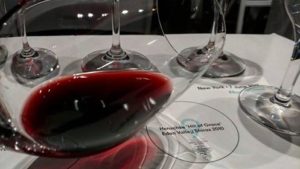 –2010 Henschke ‘Hill of Grace’, Shiraz, Eden Valley, Australia (this particular bottle was under Vino-lok glass closure but Henschke was an early adopter of the screw cap and still uses it as his main closure): The clouds parted, the music played, and so I knew that meant only one thing… it was time to taste Hill of Grace. One of the most famous Australian fine wines with the humble yet humorous Stephen Henschke leading the way. I have been fortunate to taste Hill of Grace a few times, as I used to work for a fine wine retailer in Manhattan that would give staff tastings on most things we sold. Hill of Grace is stunning… not only for an Australian wine, but it could go head to head with any other fine wine in the world. The 2010 has stewed black cherries that give it immediate accessibility but the layers of complexity are never ending… potpourri, star anise, cloves, lavender… but what is most remarkable is the great generosity of this wine although it is ethereal… on another level of lightness of being… true grace… giving everything while still seeming delicate… nothing is like it. But I am not saying anything that anyone who has ever tasted a great vintage of Hill of Grace doesn’t already know.
–2010 Henschke ‘Hill of Grace’, Shiraz, Eden Valley, Australia (this particular bottle was under Vino-lok glass closure but Henschke was an early adopter of the screw cap and still uses it as his main closure): The clouds parted, the music played, and so I knew that meant only one thing… it was time to taste Hill of Grace. One of the most famous Australian fine wines with the humble yet humorous Stephen Henschke leading the way. I have been fortunate to taste Hill of Grace a few times, as I used to work for a fine wine retailer in Manhattan that would give staff tastings on most things we sold. Hill of Grace is stunning… not only for an Australian wine, but it could go head to head with any other fine wine in the world. The 2010 has stewed black cherries that give it immediate accessibility but the layers of complexity are never ending… potpourri, star anise, cloves, lavender… but what is most remarkable is the great generosity of this wine although it is ethereal… on another level of lightness of being… true grace… giving everything while still seeming delicate… nothing is like it. But I am not saying anything that anyone who has ever tasted a great vintage of Hill of Grace doesn’t already know.
Eden Valley is “high country” with cooler nights. 2010 was an interesting vintage – heat came early with hot, low-disease conditions, and then it became cool with a little bit of rain right when they needed it. It turned out to be a magnificent vintage for them.
Hill of Grace is not a hill but it is named after the Gnadenberg Lutheran Church in the center of town. The German word “Gnadenberg” translates into “graceful hill.” The vineyard was planted by Nicolaus Stanitzki in 1860 and Paul Gotthard Henschke purchased the vineyard in 1891… it has stayed in the Henschke family since that time.
The University of Adelaide has tagged and planted some of Hill of Grace’s better performing ungrafted old vines for their soon to be released research paper that will address the attributes of such plantings. But Stephen Henschke said he would never want to only make Hill of Grace consist of those better performing vines, as he likes the diversity and thinks even the vines that seem a little odd in their production add something special that cannot be necessarily determined by science.
Final side note: Hill of Roses is the wine made up of the newer plantings from the Hill of Grace vineyard. The 2010 comes from 21 year old vines… so at least they are legal.












